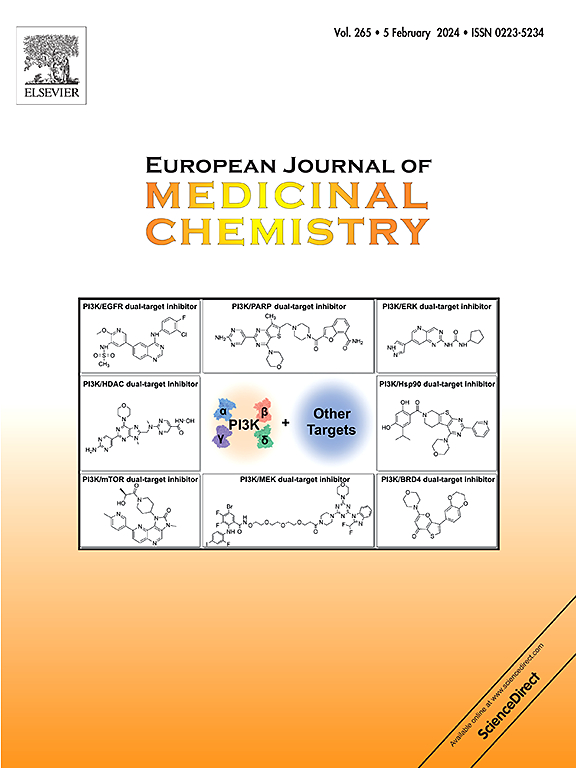NQO1 Induction and Radiation-Based Biodistribution Study of a New Quinoline Derivative Identified in a Screen of 6,8-Diiodoquinazolinone Sulfonamide Conjugates
IF 6
2区 医学
Q1 CHEMISTRY, MEDICINAL
引用次数: 0
Abstract
A series of quinazoline derivatives 10–23 incorporating benzenesulfonamide and various aliphatic, aromatic and heterocyclic acetamide tails were designed, synthesized, and in vitro evaluated for their ability to activate nuclear factor erythroid 2-related factor 2 (Nrf2) using its classical target NAD(P)H: quinone oxidoreductase 1 (NQO1) in Hepa1c1c7 murine hepatoma cells. Compounds 13 and 20 exhibited the highest potency among this series, with CD values 14 and 3 μM, respectively. The quinoline derivative 20 was subjected to radiolabeling. The radio-synthesized derivative was assessed for its biodistribution in normal and tumor-bearing animal models, where it displayed high in vivo stability and selectivity toward tumor cells. Molecular docking of 20 within the Nrf2-binding site of Kelch-like ECH-associated protein 1 (Keap1) predicted the highest binding affinity –8.76 Kcal/mol with the least RMSD value 1.01 Å. It showed a stable binding confirmed by RMSF compared to the co-crystallized ligand. This study identifies compound 20 as a promising antioxidant for continued optimization in redox-modulating research.

6,8-二碘喹唑啉酮磺酰胺缀合物中新喹啉衍生物的NQO1诱导及辐射生物分布研究
设计、合成了一系列含有苯磺酰胺和各种脂肪族、芳香族和杂环乙酰胺尾的喹唑啉衍生物10-23,并利用其经典靶点NAD(P)H:醌氧化还原酶1 (NQO1)在Hepa1c1c7小鼠肝癌细胞中激活核因子红细胞2相关因子2 (Nrf2)的能力进行了体外评价。化合物13和20的效价最高,CD值分别为14 μM和3 μM。喹啉衍生物20进行了放射性标记。放射性合成衍生物在正常和荷瘤动物模型中的生物分布进行了评估,在这些模型中,它显示出高度的体内稳定性和对肿瘤细胞的选择性。Kelch-like ECH-associated protein 1 (Keap1) nrf2结合位点内的分子对接值为20,结合亲和力最高,为8.76 Kcal/mol, RMSD值最小,为1.01 Å。与共结晶配体相比,RMSF证实其结合稳定。本研究确定化合物20是一种有前景的抗氧化剂,在氧化还原调控研究中有进一步优化的空间。
本文章由计算机程序翻译,如有差异,请以英文原文为准。
求助全文
约1分钟内获得全文
求助全文
来源期刊
CiteScore
11.70
自引率
9.00%
发文量
863
审稿时长
29 days
期刊介绍:
The European Journal of Medicinal Chemistry is a global journal that publishes studies on all aspects of medicinal chemistry. It provides a medium for publication of original papers and also welcomes critical review papers.
A typical paper would report on the organic synthesis, characterization and pharmacological evaluation of compounds. Other topics of interest are drug design, QSAR, molecular modeling, drug-receptor interactions, molecular aspects of drug metabolism, prodrug synthesis and drug targeting. The journal expects manuscripts to present the rational for a study, provide insight into the design of compounds or understanding of mechanism, or clarify the targets.

 求助内容:
求助内容: 应助结果提醒方式:
应助结果提醒方式:


